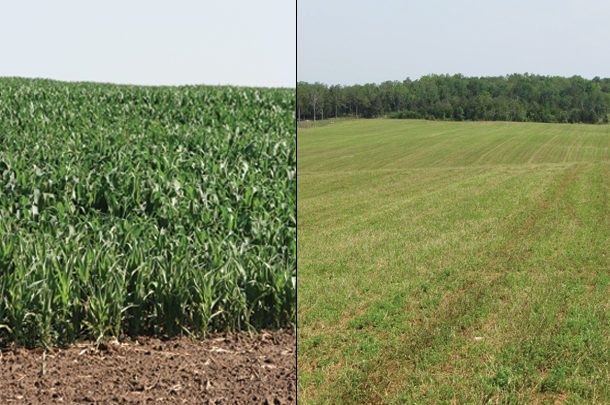Now with corn below $4 and beans under $9 per bushel and costs of production way up, maybe returning some cropland acres back to forage production makes sense.
Before making the actual conversion, two important decisions must be made. First, decide what forages to plant, and second, develop a row cropping system that is most likely to enable replanting of forages to be successful.
What to plant
The natural tendency is to plant the same forage that was growing on the land prior to the conversion to row crops. However, sometimes one of the reasons why this forage was not as profitable as desired is because it was not the best choice in that situation. It may not have been well adapted, or it might not have met the specific needs of that producer. In either case, selecting the most suitable forage to replant is critical for the overall success of the forage or livestock operation.
The best forage to replant usually depends on the type of livestock operation and what other forages currently support that operation. For example, many cow-calf operations in the Corn Belt have abundant spring pasture from cool-season grasses like smooth brome or tall fescue. However, in July and August, these pastures have low quality and grow very slowly, so calf gains suffer, cows may lose weight or conception rates are poor. More brome or fescue would do little to overcome this summer slump. Native warm-season grasses like big bluestem and indiangrass would be much better choices.
Similarly, very few pastures have adequate legumes to improve animal performance and reduce nitrogen fertilizer needs. Since legumes can be difficult to add to existing grass pasture, it is better to include them in the seeding mix when establishing new pasture.
Alfalfa often is the clear choice as a hay crop, but a pure stand may not be the best choice. Alfalfa mixed with grasses like orchardgrass or endophyte-free tall fescue may be a better option if the hay will be used on-farm for beef cattle, both for wintering cows as well as growing yearlings. Mixed hay dries more rapidly after cutting; bales shed water more effectively; animal diets have a better energy-protein balance; and weeds invade hay fields less rapidly. Tonnage remains about the same. Nonetheless, if the forage is destined to be used by lactating dairy cows, pure alfalfa usually is best.
Annual forages should not be overlooked, either, as options for these acres. Summer annuals like sorghum-sudangrass or pearl millet can provide abundant summer grazing or hay. Winter rye is an excellent source of very early spring grazing. Winter wheat can be used similarly or may be harvested later for grain if it is not needed when spring grazing time arrives. Oats and brassicas make excellent fall and early winter pasture. The greatest advantage of annual forages may be flexibility for the farming or livestock operation. It is easy to plant something different the following year if forage needs change or row crop prices become more attractive.
Cropping system management
Most failed forage plantings are due to inadequate or improper preparation. Hasty decision-making often results in poor soil conditions for successful establishment.
Prepare land for forage planting while still being used for annual row crops. Apply and incorporate lime as needed to neutralize soil acidity as much a full year prior to planting forages sensitive to soil acidity, such as alfalfa. By applying and incorporating lime prior to planting the final year of row crops or immediately after its harvest, it will give the lime adequate time to neutralize undesired soil acidity.
Control of weeds during row crop years prior to planting forages is critical because weed pressure during the year of seeding forage crops is a major cause of establishment failures. Take care in the selection of herbicides during the final year of row crops. Glyphosate-tolerant crops have reduced herbicide carryover risks, but herbicide-tolerant weeds and other weed control practices sometimes result in the use of herbicides that can prevent establishment of certain forage crops.
Another major cause of establishment failure is poor seedbed preparation. Tillage to reduce row crop residues that may inhibit proper operation of forage seeding equipment often result in seedbeds that either are too loose or have compaction zones that restrict root development of young forage seedlings.
Often, the best annual row crop to grow during the year prior to seeding forages is soybeans. Undisturbed soybean stubble usually provides a nearly ideal seedbed in terms of firmness, water infiltration rate and ease of emergence. If weeds have been well controlled in the soybeans, no-till planting of forages directly into the soybean stubble usually results in excellent seed placement and minimal soil disturbance, which thus discourages new weed development.
Stubble from small grains like wheat or oats also makes fine seedbeds. Removing straw that might smother new seedlings or cause problems with effective drill operation will increase chances of success. Volunteer small grain seedlings or other weeds can pose a competition threat, however, so control practices should be planned. The forage species planted should be compatible with any expected herbicide uses.
Heavy corn residue can make establishing new forage stands difficult. Lengthy and multiple skips are common due to poor control of depth of seed placement. Even when good stands develop, fields often remain rough from the root balls in the old corn rows. Removal of some residue, as with grazing or baling of corn stalks, will help. Tillage to smooth the field and reduce some of the residue also may be useful. FG
Bruce Anderson is an extension forage specialist with the University of Nebraska – Lincoln. Email Bruce Anderson.
PHOTO: Staff photo.










